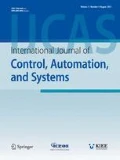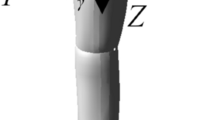Abstract
This paper develops a control algorithm to show the human-like reaching movements in humanoid redundant systems involving the trunk. This algorithm neither requires the computation of pseudo-inverse of Jacobian nor does it need the optimization of any artificial performance index. The control law accommodates the time-varying temporal properties of the muscle stiffness and damping as well as low-pass filter characteristics of human muscles. It uses a time-varying damping shaping matrix and a bijective joint muscle mapping function to describe the spatial characteristics of human reaching motion like quasi-straight line trajectory of the end-effector and symmetric bell shaped velocity profile as well as the temporal characteristics like the occurrence of the peak velocity of the trunk motion after the peak velocity of the arm motion. The aspect of self-motion is also analyzed using the null-space motion of the manipulator Jacobian. The effects of the control parameters on the motion pattern are analyzed in detail and some basic guidelines have been provided to select their proper values. Simulation results show the efficacy of the newly developed algorithm in describing humanmotion characteristics.
Similar content being viewed by others
References
T. Flash and N. Hogan, “The coordination of arm movements: an experimentally confirmed mathematical model,” Journal of NeuroScience, vol. 5, pp. 1688–1703, 1985.
Y. Uno, M. Kawato, and R. Suzuki, “Formation and control of optimal trajectory in human multi-joint arm movement,” Biological Cybernetics, vol. 61, pp. 89–101, 1989.
W. Nelson, “Physical principle for economics of skilled movements,” Biological Cybernetics, vol. 46, pp. 135–147, 1983.
Z. Hasan, “Optimized movement trajectories and joint stiffness in unperturbed, initially loaded movements,” Biological Cybernetics, vol. 53, pp. 373–382, 1986.
V. Potonjak, S. Tzafestas, D. Kostic, G. Djoudjevic, and M. Rasic, “The handwriting problem,” IEEE International Robotics and Automation Magazine, vol. 10, no. 1, pp. 35–46, 2003.
T. Yoshikawa, “Manipulability of robotic mechanisms,” International Journal of Robotics Research, vol. 4, pp. 3–9, 1984.
S. Arimoto, M. Sekimoto, H. Hashiguchi, and R. Ozawa, “Natural resolution of ill-posedness of inverse kinematics for redundant robots: a challenge to Bernstein’s degrees-of-freedom problem,” Advanced Robotics, vol. 19, no. 4, pp. 401–434, 2005.
S. Arimoto, H. Hashiguchi, M. Sekimoto, and R. Ozawa, “Generation of natural motions for redundant multi-joint systems: a differential-geometric approach based upon the principle of least actions,” Journal of Robotic Systems, vol. 22, no. 11, pp. 583–605, 2005.
S. Arimoto, M. Sekimoto, and R. Ozawa, “A challenge to Bernstein’s degrees-of-freedom problem in both cases of human and robotic multi-joint movements,” IEICE Transactions on Fundamentals, vol. E88-A, no. 10, pp. 2484–2494, 2005.
T. R. Kaminski, C. Bock, and A. M. Gentile, “The coordination between trunk and arm motion during pointing movements,” Experimental Brain Research, vol. 106, pp. 457–466, 1995.
S. V. Adamovich, P. S. Archambault, M. Ghafouri, M. F. Levin, H. Poizner, and A. G. Feldman, “Hand-trajectory invariance in reaching movements involving the trunk,” Experimental Brain Research, vol. 138, pp. 288–303, 2001.
E. Rossi, A. Mitnitski, and A. G. Feldman, “Sequential control signals determine arm and trunk contributions to hand transport during reaching in humans,” Journal of Physiology, vol. 538, no. 2, pp. 659–671, 2002.
Y. Xu and J. M. Hollerbach, “Identification of human joint mechanical properties from single trial data,” IEEE Trans. on Biomedical Engineering, vol. 5, no. 8, pp. 1051–1059, 1998.
D. J. Bennet, J. M. Hollerbach, and I. W. Hunter, “Time-varying stiffness of human elbow joint during cyclic voluntary movement,” Experimental Brain Research, vol. 88, pp. 433–442, 1992.
D. B. Lockhart and L. H. Ting, “Optimal sensorimotor transformations for balance,” Nature NeuroScience, vol. 10, no. 10, pp. 1329–1335, 2007.
T. D. J. Welch and L. H. Ting, “A feedback model reproduces muscle activity during human postural responses to support-surface translations,” Journal of Neurophysiology, vol. 99, pp. 1032–1038, 2008.
J. He, W. S. Levine, and G. E. Loeb, “Feedback gains for correcting small perturbations to standing posture,” IEEE Trans. on Automatic Control, vol. 38, no. 3, pp. 322–332, 1991.
D. J. Pearsall, J. G. Reid, and R. Ross, “Inertial properties of the human trunk of males determined from magnetic resonance imaging,” Annals of Biomedical Engineering, vol. 22, pp. 692–706, 1994.
V. Martin, A Dynamical Systems Account of the Uncontrolled Manifold and Motor Equivalence in Human Pointing Movements, Ph.D. Thesis, Ruhr-Universiteit, Bochum, Germany.
P. I. Corke, “A robotics toolbox for MATLAB,” IEEE Robotics and Automation Magazine, vol. 3, no. 1, pp. 24–32, 1996.
T. Bhattacharjee, Y. Oh, J. H. Bae, and S. R. Oh, “Controlling Redundant Robot Arm-Trunk Systems for Human-like Reaching Motion,” Proc. of IEEE/RSJ International Conference on Intelligent Robots and Systems, pp. 2000–2005, 2010.
Author information
Authors and Affiliations
Corresponding author
Additional information
Recommended by Editorial Board member Shinsuk Park under the direction of Editor Jae-Bok Song. Part of this paper was presented in the 2010 IEEE/RSJ International Conference on Intelligent Robots and Systems (IROS-2010).
Tapomayukh Bhattacharjee received his B.Tech degree from the Department of Mechanical Engineering, National Institute of Technology, Calicut (NIT-Calicut), India in 2006. He completed his M.S. degree from the Department of Mechanical Engineering, KAIST, South-Korea in 2009 and worked as a visiting scientist in the Interaction and Robotics Research Center, Korea Institute of Science and technology (KIST), South-Korea till July, 2011. He is currently a Robotics-Ph.D. Student in Georgia Institute of Technology, USA. His research interests include haptics, teleoperation, manipulation and control of humanoid redundant arm systems, and humanoid hand-arm coordination.
Yonghwan Oh received his B.S., M.S. and Ph.D. degrees in Mechanical Engineering in 1991, 1993 and 1999, respectively, from POSTECH (Pohang University of Science and Technology), Pohang, Korea. He is a principal research scientist in Interaction and Robotics Research Center, Korea Institute of Science & Technology (KIST). In 1999/2000, he was a JSPS post doc. fellow at the Mechanical Engineering of Waseda University (Prof. A. Takanishi Lab.), Japan. He is now Head of Interaction & Robotics Research Center, KIST. His research interests include mechanical design of humanoid robot, sensor based bipedal walking, robust motion control of mechanical system, and motion/interaction control of redundant manipulators.
Ji-Hun Bae received his B.S. and M.S. degrees in Electrical Engineering from Myongji University, Korea, in 1999 and 2001, respectively, and his Ph.D. degree in Robotics from Ritsumeikan University, Japan, in 2004. He is currently a senior research scientist in Division for Applied Robot Technology (DART), Korea Institute of Industrial Technology (KITECH). From 2004 to 2006, he was a postdoctoral fellow in the 21st Century COE Program at Ritsumeikan University, Japan. He worked as a senior research scientist in PIRO, from 2006 to 2008, and as a postdoctoral fellow in KIST, from 2008 to 2009. His research interests include robot manipulation, robot hands and arms, sensory feedback control, biological control, and biomimetics.
Sang-Rok Oh joined the Korea Institute of Science and Technology (KIST) in 1988 after graduation from Korea Advanced Institute of Science and Technology (KAIST) for his Ph.D. degree, and has been working as a Principal Research Engineer at the Center for Cognitive Robotics Research, KIST. During 2000–2003, he was a Head of Intelligent System Control and Robotics Center, KIST. In 1999, he also became a Director of Bio-mimetic Control National Research Laboratory, which was designated by Ministry of Science and Technology, Korea. He was a Visiting Scientist at the T. J. Watson Research Center, IBM, Yorktown Heights, NY, from 1991 to 1992. He also worked as a Visiting Scientist at the Mechanical Engineering Laboratory, Tsukuba, Japan, for three months in 1995. From September 2003 to February 2008, he has been working as a Project Manager of Intelligent Service Robots and u-Computing area at Ministry of Information and Communication, Republic of Korea, and from December 2006 to February 2008, he also worked as IT Policy Advisor to Minister at the same Ministry. From March 2008, he joined again KIST and served as a Director of Robotics/Systems Division, KIST from November 2009 to August 2010, and as a Vice President, External Affairs, KIST from September 2010 to December 2010. He is now a principal research scientist of Interaction and Robotics Research Center, and Director of R-Learning Supporting Center, KIST. His research interests include information and communication technology, bio-robotics for quality of life, and network based intelligent service robots.
Rights and permissions
About this article
Cite this article
Bhattacharjee, T., Oh, Y., Bae, JH. et al. Control design for human-like reaching movements using redundancy in robot arm-trunk systems. Int. J. Control Autom. Syst. 9, 1173–1186 (2011). https://doi.org/10.1007/s12555-011-0619-z
Received:
Revised:
Accepted:
Published:
Issue Date:
DOI: https://doi.org/10.1007/s12555-011-0619-z




